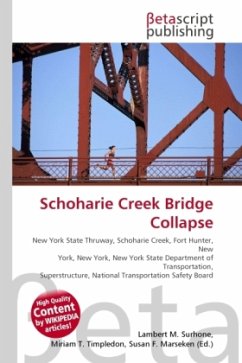
Schoharie Creek Bridge Collapse
Versandkostenfrei!
Versandfertig in 6-10 Tagen
26,99 €
inkl. MwSt.

PAYBACK Punkte
13 °P sammeln!
High Quality Content by WIKIPEDIA articles! The Schoharie Creek Bridge was a New York State Thruway bridge over the Schoharie Creek near Fort Hunter, in New York State. On April 5, 1987 it collapsed due to erosion at the foundations after a record rainfall. The collapse killed ten people. The failure of the Schoharie Creek Bridge motivated the improvement in the development of bridge design and inspection procedures. The final design for the bridge was approved in January 1952 by the New York State Department of Transportation, (previously named The New York State Department of Public Works). ...
High Quality Content by WIKIPEDIA articles! The Schoharie Creek Bridge was a New York State Thruway bridge over the Schoharie Creek near Fort Hunter, in New York State. On April 5, 1987 it collapsed due to erosion at the foundations after a record rainfall. The collapse killed ten people. The failure of the Schoharie Creek Bridge motivated the improvement in the development of bridge design and inspection procedures. The final design for the bridge was approved in January 1952 by the New York State Department of Transportation, (previously named The New York State Department of Public Works). The design described a 155 meters (510 ft) truss crossing consisting of five simply supported spans with nominal lengths of 30.5 meters (100 ft), 33.5 m (110 ft), 36.6 m (120 ft), 33.5 m (110 ft), and 30.5 m (100 ft). The bridge was supported with pier frames along with abutments at each end. The pier frames were constructed of two slightly tapered columns with tie beams. The columns were fixed in place within a lightly reinforced plinth positioned on a shallow, reinforced spread footing. The spread footing was to be protected with a dry layer of riprap.












